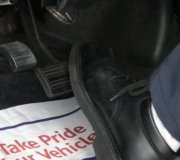You're describing a broken belt in a tire. When it's as bad you described, you should be able to raise the front tires off the ground, run it in gear, and see the hump, or "tumor" on one of the tires as it goes around. Typically just one wheel will rotate. To make the other one rotate so you can watch the tire, apply the brakes to stop the first one, then place a block of wood under it to hold it. That will force the other wheel to turn. Be careful to not accelerate too much or too quickly as that can cause the first wheel to want to spin again and shoot the piece of wood out.
It might be a good idea to review this article:
https://www.2carpros.com/articles/jack-up-and-lift-your-car-safely
The alternative is to have the steering and suspension systems inspected at a tire and alignment shop. The people there are experts at finding the causes of noises and vibrations, and at reading tire wear patterns.
This drawing shows two types of broken belts to look for. The most common is on the left. You'll see the hump in the tread as the tire goes around. Be careful when running your hands over that area as it is often accompanied by wires from the steel belts sticking out. Those really hurt when you get poked by them.
The broken belt on the right is a lot harder to spot. With this one, the belt comes apart over such a long period of time the tread has a chance to wear flat, or even, with the rest of the tread. You won't see the characteristic hump. In fact, the tire will look just fine, but in that area, the sidewall doesn't offer the support the rest of it has. That lets the wheel and spindle drop a little each time that spot hits the road surface. Very often there is that one magical speed where the vibration seems to go away. To identify that, look at the grooves as shown with my red line, instead of the tire's surface that hits the road surface. As the tire rotates, you'll see that area rise in one spot. It can take a trained eye to determine if that is bad enough to call a broken belt. There's also little bumps in those grooves that are wear indicators. Those are much smaller than the raised area caused by a broken belt.
With either type of broken belt, an easy way to see it is to watch the steering wheel oscillate back and forth at low speeds, as in when driving through a parking lot. If the broken belt is on a rear tire, you'll feel the seat go up and down, but the steering wheel will remain pretty much motionless.
If it's still confusing, switch a pair of wheels and tires on one side from front to rear, then drive the car to see if the feel or steering wheel oscillations have changed. If the symptoms are the same, switch the two wheels and tires on the other side and try again.
Many people, even inexperienced mechanics, will assume a wheel is out of balance, but the clue here is your observation the vibrating starts as low as 20 mph. You won't feel any imbalance at speeds that low. Even the worst balance problems don't show up until 40 to 50 mph.
A bent wheel can cause similar symptoms. Again, if it's on the front, you'll see it in the steering wheel. If it's on the rear, you'll feel the back of the car moving back and forth. A bent wheel will show up when running them with the car raised up, the same as when you're looking for a broken belt. Watch the lip of the wheel where the weights get attached. If you see that area move left and right as the wheel goes around, that is called "lateral runout". There is usually an allowable specification for that, but it can be too hard to see by eye. We use a dial indicator to identify that runout, but by that time it is so slight as to not cause noticeable symptoms for most people. If you can easily see that runout, it's a lot and is the best suspect.
Let me know what you find.
Image (Click to make bigger)
Saturday, December 3rd, 2022 AT 4:15 PM




